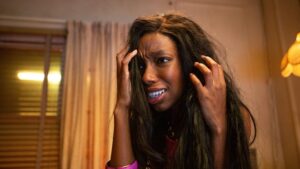
A new Hulu horror-comedy, “Bad Hair,” tackles the unspoken issue between Black women and their hair in an image-obsessed society. The underlying messages of this film attempted to shed light on the ongoing battle for Black women to adhere to false beauty standards, despite their preferences.
The Justin Simien-directed film is set in 1989 where the main character, Anna Bludso (played by Elle Lorraine), is a young woman in the music television industry whose hard work has continuously gone unnoticed. She decides to get a weave based on the recommendations and weave-filled representation of Black women on television, even though her natural hair was comforting, and her close friends disagreed.
She later finds that her new weave may have bad intentions to take over her life, which is where the horror comes in to play.
While the director decided to tackle such a home-hitting topic for many Black women, it constantly felt like it was missing something — actual dialogue regarding the inner struggles for the Black women involved. The movie spent a lot of time plot-setting, drawing out long horror-action scenes, and establishing almost every character of the very large cast without focusing on the long-lasting effects of hair discrimination and unapologetic hair-loving journeys of the individual characters.
The movie seems to lack focus for the foundational message with its overly saturated satire and horror. It hardly addresses the pressure from society that natural hair is not beautiful, which continues to hold strong in the workforce. It makes the idea of “good hair” and “bad hair” seem like micro-aggressions against Black women, but these experiences are not always subtle and continue to make more Black women self-conscious and irate toward their hair.
While this movie confronted how society’s obsession with the “perfect image” has constantly left out natural Black women, the movie could have done a better job of being more inclusive to women who honestly like to wear a weave. There are plenty of Black women who decide for themselves to wear weave, which does not mean that they do not love their hair or want to abide by ridiculous beauty standards.
With that being said, the film can be used to back up the “just wear your natural hair” comments from others when a women’s hairstyle is no one else’s decision, but her own. These kinds of comments constantly contradict society’s conflicting beauty standards where Black women are shamed for wearing weaves and undermined for wearing their natural hair. This is a major topic that should have been thoroughly addressed, but it was only referenced in the short opening scene.
According to Rotten Tomatoes, a movie review platform, the movie has only received positive reviews from 62% of respondents on the site.
“Justin Simien’s latest throws a little too much at the screen,” said a Rotten Tomatoes critic.
The vague references to this Black hair struggle were not nearly enough to hold this movie together, which left a lot of plot holes, unnecessary scenes, and certain audiences wanted less of the horror and satire and more of a clear thesis.
For long-standing societal issues like these that have plagued the self-confidence of many Black women and girls for decades, it is necessary to address it head-on rather than negligibly. ‘Bad Hair,’ delivered a couple of laughs and gruesome moments, but overwhelmingly displayed the basis and experiences of this struggle.